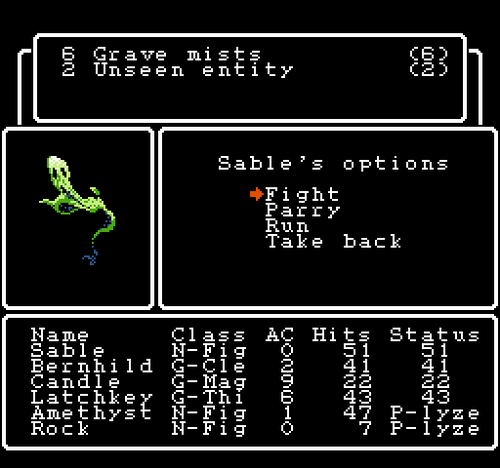Wizardry: Proving Grounds of the Mad Overlord

This one's a kind of bonus. After we played AD&D, I really wanted to do a session of Wizardry with my students, as a way to discuss the enormous impact tabletop role-playing has had on the aesthetics and design of digital games. The way I imagined it would have been awkward to set up and run in class, though. Late in the quarter, I had to take a class remote (I forget whether for health or weather reasons, but my bet's on the former) and I realized that would be the perfect opportunity.
Importantly, we did not play Digital Eclipse's recent, celebrated remake of Proving Grounds of the Mad Overlord. That version has an auto-map, and mapping was a core part of the game that I wanted students to experience. Nor did we play the Apple II original, which is rather fiddly to emulate. Our compromise was the Game Soft's 1990 NES port (actually my favorite version) with the AC bug patched.
I definitely recommend having some familiarity with Proving Grounds before trying to run it in class. I would try to at least reach level 2 of the dungeon with a set of characters before taking students into the game.
Prep:
- Provide students with a link to the scanned Wizardry NES instruction manual, hosted on archive.org. This will be an important resource to keep on hand during play.
- Ask students to come prepared with several sheets of graph paper. If they can't find graph paper, they can print out one of the many graph paper templates available online (you can even link one yourself if you like).
Running:
- It'll work like this: You're going to actually play the game, screen-shared with students. Student tasks are to try and keep an accurate map of the dungeon as it's being explored, consult the manual for important information (ie, what a spell does), and suggest character names and possible courses of action (ideally in chat).
- You can use pre-made characters (the game comes with a complete party), but I think it's more fun to have students create the party. Don't worry too much about the stats, but do use this as an opportunity to have students look up which Wizardry races are statted for which classes in the manual. You'll want to end up with a party of probably three fighters in front, followed by a priest, a thief and a mage. Good and Evil characters can't share the same party, so ask students to choose an alignment for their party (they will probably choose Evil).
- Make sure to outfit your characters at Boltac's Trading Post – there's a guide to starting equipment in the back of the manual.
- Invite students to map the dungeon as you play. You can model what hand-mapping looks like for them, if possible – I have a USB document camera, but it wasn't working the day of. Move slowly and call out your movements as you do them, as the dungeon is very samey-looking and it is hard for a spectator to follow otherwise.
- Toss important decisions to students. "One of our fighters just died. Should we flee this battle or try and finish the fight without them?" "Should we save up to resurrect this character or just roll a new one?"
Discussion:
- Obviously, having so much of the Wizardry experience be external to the actual game software – the manual full of reference material, the required graph-paper mapping – was driven by the memory limitations of computers at the time. But does the game gain anything from being a kind of composite of both digital and physical elements?
- There's obviously a lot of aesthetic overlap between something like D&D and contemporary games like Elden Ring, but does Wizardry display any fingerprints of being based on a game where the fundamental activity is sitting around a table, talking through what happens with other people?
- What other games have a clear line of descent to D&D? What other D&D game mechanics show up in contemporary games? Some seminal games with direct ties to D&D are Will Crowther and Don Woods' Adventure, Richard Garriott's Akalabeth and Ultima series, Yuji Horii's Dragon Quest series, and Michael Toy and Glenn Wichman's Rogue. A mechanic from D&D that shows up in contemporary games of almost every genre is collecting experience points to "level up."
Bonus activity: Construct a memorial for fallen characters.
Get History of RPGs
History of RPGs
A history of tabletop role-playing in four games
| Status | Released |
| Author | Anna Anthropy |
| Genre | Educational |
| Tags | Classes, history, Tabletop role-playing game |
More posts
- We Are But WormsSep 04, 2025
- Apocalypse WorldSep 03, 2025
- AD&D: Tomb of HorrorsSep 02, 2025
- DiplomacySep 01, 2025
Leave a comment
Log in with itch.io to leave a comment.